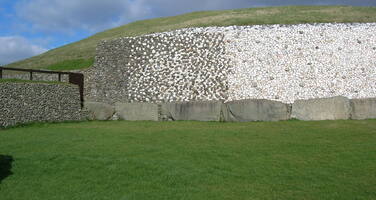Brú na Bóinne - Archaeological Ensemble of the Bend of the Boyne
Factors affecting the property in 2004*
- Localised utilities
- Management systems/ management plan
Factors* affecting the property identified in previous reports
Urban Pressure
International Assistance: requests for the property until 2004
Total amount approved : 0 USD
Missions to the property until 2004**
Conservation issues presented to the World Heritage Committee in 2004
Following the request by the World Heritage Committee, a joint UNESCO-ICOMOS reactive monitoring mission to the site took place from 17 to 21 February 2004. The main aim of the mission was to evaluate the impact of a proposed municipal waste incinerator approximately 1.5 km from the buffer zone and 3.5 km away from the edge of the inscribed area.
The planning application has proved to be very controversial as demonstrated by a large number of objections following receipt of the application by the Meath County Council, the planning authority in January 2001. An Environmental Impact Assessment (EIA) carried out by the applicant, Indaver Ireland, accompanied the application. The national appeal board's decision, which granted permission in March 2003, is currently subject to a judicial review. Parallel to the planning process, the Irish Environmental Protection Agency (EPA) has also been assessing the application for a Waste License since December 2001. EPA has advised the Meath County Council in March 2004 to increase the height of the stack from 40m to 65m in order to facilitate further dispersal of potential emissions. This recommendation overrides the existing planning consent according to the Irish legislation.
Having visited the site as well as examined the available planning documents and the EIA, the mission concluded:
(a) Direct possible impacts: The application site has been subject to an archaeological assessment which concluded that there was no evidence for the existence of any archaeological material on the site and certainly nothing to suggest any cultural remains from the megalithic period.
(b) Visual impacts: The application area for the waste incinerator is separated from the core zone by a ridge of high ground with Red Mountain at its western end and Donore Hill at its eastern end. Between the two hills there is a saddle on which lies the village of Donore. From the core zone there are protected views from Knowth, Newgrange and Dowth. The views from Newgrange and Dowth are somewhat compromised by two factory chimneys belonging to the 30 years old cement factory which are clearly visible on the eastern side of the Donore saddle. The applicant provided photomontages and lines of sight information which indicated that the stack at its height of 65 m will be visible from Dowth but not from Newgrange. While the construction of the incinerator stack will be a visual intrusion the mission considered that it would have a minimum impact on the World Heritage site compared with the existing cement factory nearby.
(c) Polluting emissions: The estimated chemical composition of the emissions is provided in the EIA and the Centre is seeking scientific advice from appropriate experts such as the ICSU. According to the assessment commissioned by the applicant the emission of pollutant such as SO2 and Nox are well within the regulatory limit set by the EU and other European Bodies while there is no defined standard relating to the effects of ambient air pollutants on stonework or historical monuments.
(d) Management Plan: Brú na Bóinne World Heritage site Management Plan was published in December 2002 by the former national heritage service, Dúchas. The Management Plan had not been submitted to the Centre and ICOMOS prior to the mission.
The mission also considered a number of other issues concerning the state of conservation of the World Heritage property such as future infrastructure development and the definition of the buffer zone.
Summary of the interventions
Decisions adopted by the Committee in 2004
28 COM 15B.72
Archaeological Ensemble of the Bend of the Boyne (Ireland)
The World Heritage Committee,1. Noting the outcome of the joint UNESCO-ICOMOS mission to the property and that the requested Environmental Impact Assessment for the proposed waste incinerator has been provided to the World Heritage Centre and the Advisory Body, ICOMOS,
2. Urges the State Party to consider all recommendations made by the UNESCO-ICOMOS monitoring mission of February 2004, in particular concerning visual and polluting impacts as well as buffer zone definition;
3. Requests that the World Heritage Centre be kept informed of any further changes in the design of the incinerator as well as the completion of the project in order to confirm that the visual impacts are as minor as anticipated.
Draft Decision:28 COM 15B.72
The World Heritage Committee,
1. Noting the outcome of the joint UNESCO-ICOMOS mission to the property and that the requested Environmental Impact Assessment for the proposed waste incinerator has been provided to the Centre and the Advisory Body, ICOMOS,
2. Urges the State Party to consider all recommendations made by the UNESCO-ICOMOS monitoring mission of February 2004, in particular concerning visual and polluting impacts as well as buffer zone definition;
3. Requests that the Centre be kept informed of any further changes in the design of the incinerator as well as the completion of the project in order to confirm that the visual impacts are as minor as anticipated.
Exports
* :
The threats indicated are listed in alphabetical order; their order does not constitute a classification according to the importance of their impact on the property.
Furthermore, they are presented irrespective of the type of threat faced by the property, i.e. with specific and proven imminent danger (“ascertained danger”) or with threats which could have deleterious effects on the property’s Outstanding Universal Value (“potential danger”).
** : All mission reports are not always available electronically.


